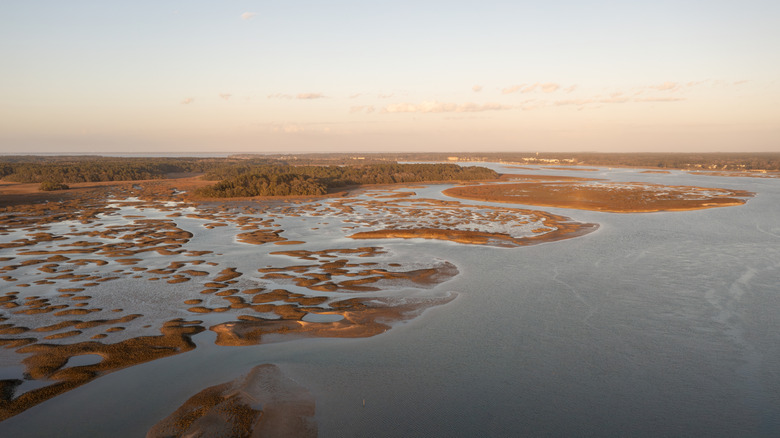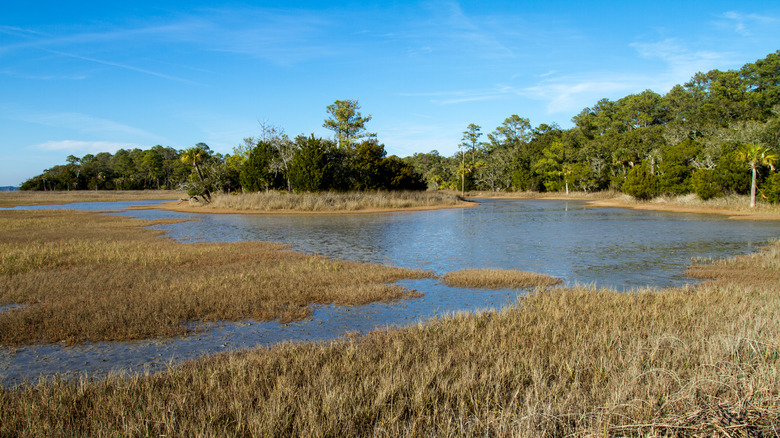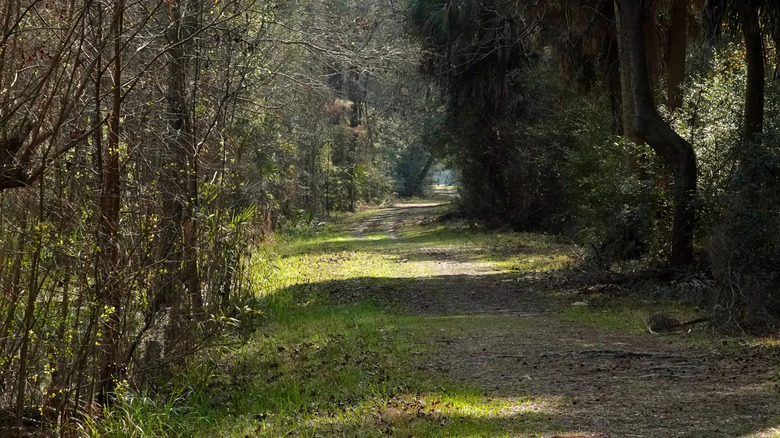Wildlife Thrives In This South Carolina Island Preserve Perfect For Coastal Hiking And Biking
South Carolina's Pinckney Island has a pretty interesting history. Throughout the 1800s, the 1,200-acre water-bounded plot of land was part of a plantation owned by Revolutionary War veteran and statesman Charles Cotesworth Pinckney — one of the Founding Fathers who signed the Declaration of Independence back in 1776.
The back-barrier island, which lies between Hilton Head Island and Bluffton, an underrated foodie town known as South Carolina's "Heart of the Lowcountry," has changed hands several times since then. After being turned into a private hunting preserve in the 1930s, the land was donated to the U.S. Fish and Wildlife Service in 1975, opening to the public as a refuge a decade later. (Though hunting is still permitted in-season.) Today, wildlife thrives on the marshy grounds, officially known as the Pinckney Island National Wildlife Refuge. The protected area now boasts a little over 4,000 acres, including the surrounding Corn, Buzzard, and Big and Little Harry Islands. Pinckney, which is the largest of the islands, is the only one available for public use, welcoming about a quarter of a million visitors each year.
Roam the wilds on a bike, or enjoy a stroll along one of the coastal trails. Open daily from sunrise to sunset, the refuge is free to visit. Be prepared for a solo adventure, though, as the preserve is quite bare-bones. You won't find any staff on duty, and there aren't any amenities, such as restrooms, fountains, or shelters. So be sure to pack plenty of water, and check the weather forecast before plugging this destination into your GPS.
Raptors and bobcats and gators, oh my!
It's no secret that Florida has some of the most alligator-filled destinations, but South Carolina is swarming with the reptilian beasts, too. In addition to American alligators, the Pinckney Island National Wildlife Refuge harbors a variety of other reptiles, such as cottonmouth, black racer, and yellow rat snakes. Bobcats, white-tailed deer, red foxes, river otters — you name it — countless species are bouncing around this refuge. You're bound to see some form of wild critter as you roam the protected area.
Thousands of migratory birds stop over in the refuge, too, putting this part of South Carolina up there with some of the best birdwatching destinations in the country. "The birds are spectacular and the whole area is so unspoiled," one former visitor wrote on Tripadvisor in August 2024. "Beautiful area. We saw an armadillo and a lot of very cute tiny crabs!"
If you mosey over to Ibis Pond, which is the first waterhole you'll reach from the parking area, you can see a rookery. The nesting habitat is home to many colonial wading birds, among them egrets, herons, and, of course, white ibises. In all, more than 250 types of birds have been observed at the refuge, from long-legged shorebirds to predatory raptors. You can go online and print out an eBird checklist if you'd like to keep track of your bird sightings. As you wander through the preserve, see if you can spot the most popular species of all — the painted bunting, a colorful commoner in the summertime.
Leave footprints, take pictures
The Pinckney Island National Wildlife Refuge is a magnet for wondrous wildlife thanks to its diverse habitats, from the rustling freshwater ponds to its dense forests and vast grasslands. Wander through the nature abyss by hiking or biking the preserve's more than 14 miles of trails, made up of gravel roads and grassy paths. All of the trails begin and end at the parking area, which is located about a half a mile from the refuge's entrance just off U.S. Route 278. So, to recap, you have a lot of trekking in store.
The 1.2-mile jaunt to and from Ibis Pond will take you about 1.5 hours to complete, depending on how fast you walk and how many stops you make along the way. Forge on deeper into the coastal refuge to see other mini lochs: the Starr, Osprey, Nini Chapin, Clubhouse, and Dick Point Ponds. If you get to Pinckney Island bright and early, you can catch the tail end of the sunrise views from the preserve's Shell Point, Bull Point, and White Point vistas, the trails of which span 4.6, 5, and 7.8 miles round-trip, respectively.
Fido must stay home, though, because pets are not allowed in the refuge. Steering off the trails while biking is also not permitted. You should always endeavor to stay on the marked paths regardless of how you're tackling them — either on foot or on bike. Always watch out for potentially dangerous wildlife and plants as you roam, such as alligators, snakes, poison ivy, and the like. Needless to say, bug spray and sunscreen will also come in handy.


